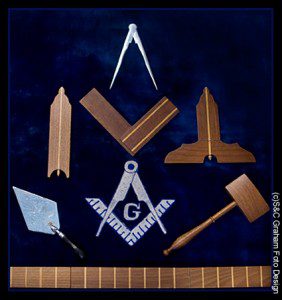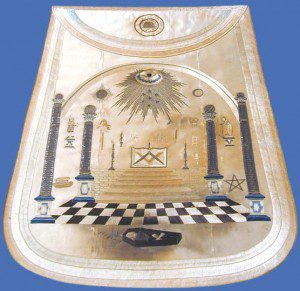
Karsceal Turner – I Got Next
Part one of this series was an attempt to reveal to you that masons walk amongst us. Judges, doctors, lawyers, senators, and yes, even preachers. I once saw with my own eyes, a 60-something minister preach the word wearing a masonic apron.
However, I digress. My conversations with masons revealed a surprisingly average way to become one if one’s heart desires. One must simply ask a mason. Surprisingly simple, no?
What is a mason? A quick Google will reveal a Freemason as a member of the Free and Accepted Masons, an international fraternal and charitable organization with secret rites and signs.
Some people take issue with the secret rites and signs parts. Again, to be fair we must look also at secret rites and signs in making a member of the Skull and Bones, or Hellfire club, or dare I say a Pope? Don’t damn me.
The question then becomes…who DOESN’T have secret rites and signs?
This series is derived from conversations from members of the freemason organization (Black and White) and from varied denomnations. They were open and welcoming of my probing questions. They were also adamant about correcting discrepancies about their organization and the brotherhood it encompasses.
What is a freemason?
The short answer and ideology stems from the age-old stone masons of the quarries of Kemet. However, more recently they are derived from the medieval stone mason guilds, who had a system of secret signs and passwords with which they recognized each other.
This was a time when one’s words were kept inviolable in one’s heart. In other words, hypocrisy and deceit were unknown as family units passed down the secrets by oral dictation coupled with on the job training.
Much of that tradition is evident in certain signs, tools and grips freemasons use. The tools were used allegorically to enhance one’s humanity and spiritual path and were technically no different from how parables were used in the bible.
If one takes a closer look beyond what the media feeds them, the most resounding answer I received from masonic respondents was one term – A Brotherhood.
How to become one? Ask one. It is as simple as that. However, after a petition for candidacy involving a background investigation, insight into to one’s family obligations, followed by the strict scrutiny of local lodge brothers, one still may or may not be accepted. It only takes one brother’s dissent to disqualify a candidate.
This makes sense. After all people are judged by the company they keep. One bad Mason casts a shadow the mainstream population rarely forgets.
Once admitted for membership, training begins in the practice of becoming an upright man. That is, one of good moral character, duly and truly prepared mentally, and properly vouched for among his masonic peers. The United Grand Lodge of England (which has no direct authority over other Grand Lodges, but as the world’s oldest Grand Lodge, has a historical influence in terms of regularity and practice) defines “pure, ancient Freemasonry” as consisting of the three degrees of Entered Apprentice, Fellow craft, and Master Mason. I spoke of this in part one. Again, this correlates to the medieval stonemason guilds when folks didn’t see it as “too secretive.”
What’s with all the Denominations?
Indeed, there are a few variations within the masonic order. I shall list some here: International, Prince Hall, Ancient Free and Accepted, and Modern Masons are a few.

Undoubtedly I left off some but I’m sure I could double the list in terms of church organizations on a given busy thoroughfare in Central Florida. One might see 13 churches on one road with these varying denominations: Baptist, Catholic, Seven Day Adventist, AME, CME, COGIC, protestant, Islamic, Latter day Saints, Pentecostal, or any number of created churches bearing the name; Lighthouse, Temple, or “House of prayer” but still supposedly serving one God.
And so it is within freemasonry that there are varying denominations. However, all the denominations are linked through the first three degrees of the lodge and the fact that no woman can be made a master mason. I’ll speak more on the sister organization, known as the Order of the Eastern Star later.
Black and White masons in the same lodge?
In terms of racial equity, one of the better examples of tolerance was perhaps within the Masonic Lodge.
Case in point: Shane Bevilacqua, 26 is the Junior Warden of Abraham Lodge #587, International & Modern Masons located in Daytona Beach. The lodge membership of Abraham #587 is predominately Black.
Bevilaqua, who is white, gave his assessment of his life as a lodge member.
Not only is he Bevilaqua an integral, elected lodge officer, he also is a community servant through his position as Community Representative at the American Cancer Society.
“Just after my 21st birthday I started a new job. One of my co-workers was a freemason. I had never heard of freemasonry in my life but I was curious because it just seemed like a bunch of friends hanging out together. Since it was good, clean fun and I loved to be social I made the decision to join their mason lodge. I did not know it at the time but my life would forever be changed in the most abundant of ways.”
Charles Thomas is qualified to co-sign Bevilaqua’s comments. Thomas, 32, is the most Worshipful Master (president) of Abraham #587 and is Beviaqua’s masonic mentor. He is a Black man and has been a leader amongst masons for eight years in his current post after joining at age 18.
“The beautiful part is that Masonry was supposed to sit down people of all cultures to get over the humps society created. It was supposed to be universal. A lot of prejudice is perpetuated in masonry but that isn’t what it was intended for. Any man deemed with an upright character and vouched for should be able to practice the art, regardless of color since we are the men of enlightenment,” Thomas said.
“It has not been without struggles but we exhibit true brotherhood. Brother Bevilacqua gives a different perspective and look and it goes to show that at least we are living what we preach. He is as much a brother as anyone within our ranks. He jokes about infiltrating the black community but we have learned much during our various interactions. We have similar circumstances, and trials. There is brotherhood across the board. A good brother is a good brother, no matter the color,” he added.
Bevilacqua picked up where his mentor left off.
“As I began to learn and grow as a freemason I saw the world through different lenses. Things that were once important slid down the priority scale and things that didn’t seem too serious rose in importance,” he said.
“The lodge I joined, Abraham #587, was very dedicated to improving themselves and the immediate world around them. Since positive human interaction and social good were already so important to me, my hunger and thirst for growth within this masonic system grew at an equal rate. I became learned in the art of freemasonry and channeled my passion into passing on what I learned to new freemasons.”
Next: Part Three anti-masonic atmosphere


